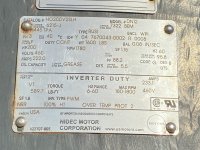A water supply company reported a tripped 400A breaker and unbalanced motor run currents. Nothing was obvious and a recorder was added at the 500kVA padmount transformer. The 200HP motor is the only load. This motor is on a soft start. That motor is a Nidec Vertical Hollow Shaft, Stock, 200 HP, 1780 RPM, HO200V2SLH, 460 V, 60, H445TPA.
The motor starting current average is 775A. The run average is 225A. When the motor shuts off, current goes to 650A and then falls to zero.
Is this because it is moving water?
The water supply company will be rolling their phases to help determine source or load issue. Plant is six years old with no problems. The cause of the 400A breaker tripping is still unknown. Pump starts from tank demand, so the start/run times do vary during the day.
I want to understand the high stopping currents.
Thanks,
The motor starting current average is 775A. The run average is 225A. When the motor shuts off, current goes to 650A and then falls to zero.
Is this because it is moving water?
The water supply company will be rolling their phases to help determine source or load issue. Plant is six years old with no problems. The cause of the 400A breaker tripping is still unknown. Pump starts from tank demand, so the start/run times do vary during the day.
I want to understand the high stopping currents.
Thanks,


